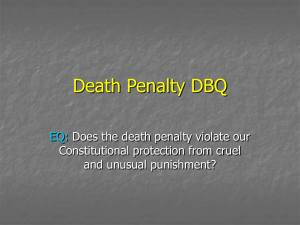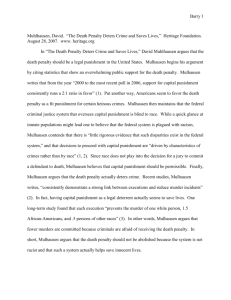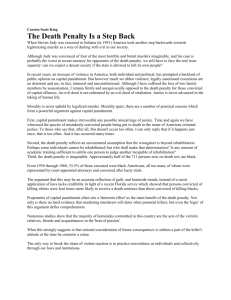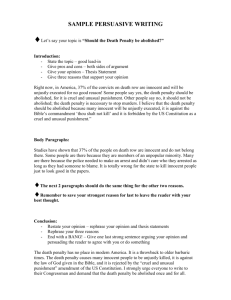FURMAN V, GEORGIA: LAST RITES FOR THE DEATH PENALTY?
advertisement
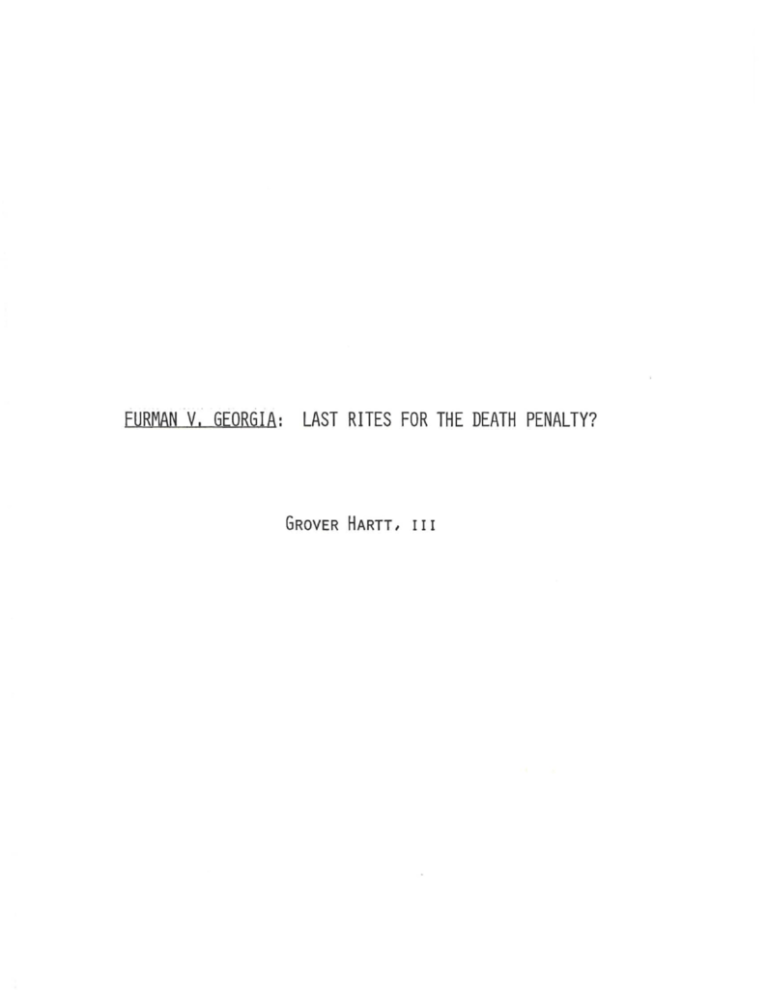
FURMAN V, GEORGIA: LAST RITES FOR THE DEATH PENALTY? GROVER HARTT, III FURMAN V. GEORGIA: LAST RIGHTS FOR THE DEATH PENALTY? On June 29, 1972, the Supreme Court held the death penalty unconstitutional as a violation of the proscription ·. of cruel and unusual punishments in the eighth amendment. 1 Significantly, the laconic per curiam opinion only held unconstitutional the three statutes before the court 2 and refrained from holding the death penalty unconstitutional per se. Almost immediately intense debate developed con- cerning whether new statutes imposing capital punishment would be constitutional. Five states have since approved legislation which purports to reinstate the death penalty, six~h and a . tat ·~on may have done so by means of judicial interpre- 0 f an .. ex~st~ng statute. 3 The unanswered question, and the question which this paper will attempt to answer, is whether such efforts are constitutional. sary to specul~te To arrive at a conclusion it will be neceson what will satisfy the Furman Court. Before analyzing Furman, however , it is essential to consider . the two concepts which constituted its milieu: unusual punishment and discretionary sentencing. Cruel and After that, attention can be given to the Furman decision itself. Then the implications of Furman upon attempts to reinstate capital punishment can be assessed • . THE LAW PRIOR TO FURMAN The specific provision of the, constitution which was offended by the imposition of the death penalty in these cases was the prohibition against cruel and unusual punishments. 4 Analysis of this concept is therefore important to examination of legislation subsequent to Furman. Although the methods of execution presently used in the United States had been assailed as cruel, the Supreme court had never held them to be within the ambit of the eighth amendment. 5 It is noteworthy, however, that immediately prior to Furman the California ,supreme court held that capital punishment violated the cruel or unusual punishment provision of that state's constitution. 6 Before Furman the Supreme Court had considered cruel 'and unusual punishment on only a few occasions. Usually it had refused to invalidate a punishment as unduly severe so long as it was ,within statutory requirements. 7 This result obtained even when the sentence of a particular offender was far in excess of those given similar offenders. 8 It had also : ,0 been held that the eighth amendment did not apply to the . . states. 9 -2- One of the first instances of voiding a punishment by means of the ,e ighth amendment was Weems v. United States. 10 In that case the defendant was convicted of falsifying an ,entry in a government cashbook. Under Philippine law the defendant was, sentenced to cadena , temporal: Twelve years , of hard and painful labor with "accessories". Accessories included chains on the ankles and wrists, perpetual loss of all civil' rights, and subjection to surveillance during life. Some years later denationalization of a military deserter was held cruel and unusual in Trop v. Dulles. 11 Thereafter, the court in Robinson v. California also refused ,to allow a state to make narcotics addiction a crime. 12 Such a stat;ute was unconstitutional under the eighth amendment because it ' made "mere status" a crime. Robinson was further significant in that it specifically held the eighth ' amendment ap,J;>licable 'to the states via the fourteenth amendment. In spite of the fa,c t that until Furman the Court had never addressed, the ' question of whether the death penalty was a cruel and unusual punishment, the issue was not entirely new. , ,Nearly a ' century before, the Court held that the eighth , . amendment did. not prohibit death by shooting. . 13 While it seems implicit that the ,Court would , have then rejected the -3- argument that capital punishment was per se cruel and Unusual, it is important that the question then before the Court concerned not the penalty but a particular means of ' 1 ementl.ng ' ,14 l.mp l.t. Similarly, the Court subsequently held that the electric chair was not a cruel and unusual method ' 15 o f ' execu t l.on. In an especially bizarre situation involv- , ing the mechanical failure of an electric chair, a second attempt to execute the , condemned man did not constitute ' d y or crue l ' and unusua l ' h ment. 16 d o ubI e Jeopar punl.S over~ More- there was dicta in Trop stating that the death penalty was not ' prohibited by the eighth amendment. 17 The years immediately prior to Furman did see several extensions , of the cruel and unus~al punishment doctrine. lS Most important among these was its application to rape. ' In Maxwell v. Bishop" , the Eighth Circuit--per then Circuit Judge Blackmun--held ' that the death penalty for rape was not unconstitutional. 19 Substantial statistical information tending to show that the penalty was arbitrarily imposed was rejected. When , the case reached the Supreme Court in 1970, it was remanded to the district court on a different ground, ,and the cruel and unusual punishment issue was not reached. 20 But in tha,t same year, the Fourth Circuit decided in Ralph v. Warden that death for rape in ,'which the victim's life was , , , , 21 not endangered did constl.tute cruel and unusual punl.shment. -4- Using language which foreshadowed Furman, the court held: "Infrequent imposition of the death penalty , for rape not only indicates that it is excessive, 22 it also suggests that it is meted out arbitrarily." On the basis of these rather limited excursions into ,the concept, of cruel and unusual punishment, the decision , in Furman that capital punishment could in fact transgress the eighth amendment was a definite expansion. Even more remarkable was the manner in which this result was reached. Although at least two members of the majority considered the death penalty to be cruel and unusual per se, the remaining ,three were conc'e rned with the procedures by which it was , ' 23 assessed. They would hold that capital punishment is cruel an,d unusual , because of the arbitrary sentencing procedures by which it is imposed. This result was achieved by making : a dramatic departure from the acceptance of discretionary 'sentencing. Until Furman the , courts appear to have been favorably disposed toward discretionary sentencing. The year before Furman was 'decided, the Supreme court specifically approved , discretionary sentencing in capital cases. 24 The Court said in this country there , was almost from the beginning a "rebel' ,lion against the common-law rule imposing a mandatory death sentence on all convicted murderers." 25 By 1972 this rebel- lion had reached the point where :the death penalty was dis-'5- , ' 1a1 "Jur1s d"1ct10ns wh'1Ch prOV1'd ed f or 1t. ' 26 cret10nary 1n Maximum discretion was viewed as essential to the sentencing process. 27 One of the first steps down the road to maximum discretion was Winston v. United States. 28 There the Supreme Court noted two methods for avoiding a mandatory death sentence for murder: Defining degr~ of murder or allowing the jury discretion regarding punishment. Half a century later, the Court added a new dimension to discretionary sentencing by permitting a trial judge to disregard the jury's verdict recommending life imprisonment and sentence the , defendant to death. 29 Discretion was justified as a means of making the punishment fit the crime. 30 Nevertheless, the development of discretionary sentencing did not go uncriticized. The practice, at least as performed by juries, was attacked as giving too much play to arbitrary factors such as the personality and eloquence of the defendant's attorney, and to the defendant's demeanor and age. 31 Another critic concluded , that juries generally assess heavier sentences and that jury sentencing was nothing more than "santicified , 32 guess1ng". , The state courts, however , continued to give implicit recognition to the jury's discretion in -6- sente~cing.33 While still a circuit judge, Mr. Justice Blackmun refused to overturn death sentences which were within the discretion of ' I' , 34 f edera Jur1es. Meanwhile, the Supreme Court had made the first inroads into this discretion by noting the importance 0 " f sta,n d ar d s to gU1'de t h e Jury s ver d'1ct. 35 The first ,real chink in the panoply of the jury's discretion came when the Court held that portions of the federal kidnapping law had a chilling effect on the constitutionally protected right to counsel. If a defendant was tried before a judge, then he was protected from the ,p o's sibi1ity of capital punishment: but if he was tried before a jury, then such punishment was within ' d '1scret1on. ,36 1tS Later the same year, the Court addressed another f~ of jury sentencing in capital cases in witherspoon v. Illinois. The Court held that the prosecution could not "stack the deck" against the defendant by excluding all potential jurors who 'merely expressed qualms about the death penalty. 37 Important to the decision in Witherspoon was the Court's concern that the jury reflect the "conscience of the community" regarding ' the death penalty. , 38 The controversy surrounding discretionary sentencing in , I cases SEleme d ,to b Id ' 39 cap1ta e reso ve '1n McGaut h a v. Ca l'1 f orn1a. ",, " After discussing the development of discretionary sentencing in capital cases, the, Court held that the Due Process Clause -7- of the fourteenth amendment did not require standards to guide that discretion. In a companion case, crampton v. Ohi·o , the Court further held that discretionary sentencing . by the jury did not necessitate a separate punishment hearing. It is significant that the Court expressly reserved the question of the constitutionality of the death penalty itself. The Court concluded: "In the light ·of history, experience, and the present limitations of human knowledge, we find it quite impossible to say that committing to the untrammeled discretion of the jury the power to pronounce life or death in capital cases · is offensive to anything in the Constitution.,,40 Conversely, the three dissenters, Justices Douglas, Brennan and Marshall, expressed confidence that standards could be · devised to provide safeguards against what they viewed as ' 41 ·· arb'1trary sent enc1ng. TH~ DECISION IN FURMAN V. GEORGIA Against this background, the Supreme Court decided Furman v. Georgia. curi~m The brief per opinion holds that the death penalty violates the eighth amendment "in these , cases". 42 "These cases" were a Georgia conviction for murder, a Georgia conviction for rape, and a Texas conviction for rape. 43 . nothing. " Beyond that holding, thE! per curiam opinion says Yet its brevity belies 'the Court • s turmoil in reach- ;"8- ing that final decision. Each of the nine members of the court filed an opinion, and of the five concurrences, hone was joined by another justice. For these reasons, analysis of what Furman really holds and what the Court would do if .confront.e d .w ith a new death penalty statute is admittedly speculative. Because of the diverse individual opinions, it is necessary to examine what each Justice said. From .this examination emerges a composite holding which might command the support of five Justices. The Court's senior member, Mr. Justice Douglas, concurred ,in the judgment of reversal but did not rea;ch the question of whether a mandatory death penalty would violate the eighth ,amendment. 44 Admitting that the death penalty was not originally cruel and unusual punishment, he asserts that the concept is not static, but is one which "evolves" ,45 as society "matures". Mr. Justice Douglas also finds that the theme of Equal Protection is implicit within the meaning of cruel and unusual punishment. 46 Equal Protec- tion is denied , when capital punishment is only imposed on minorities: The poor, the blacks, the uneducated. After this attack on discretionary sentencing, the Justice goes on to make another .point very crucial for future statutes. Any statute, even ,o~e imposing a mandatory death penalty, -9- while satisfactory on its face, may still be unconstitutional ' ' t'10n •47 en f orcemen t resu·I t s '1n d'1scr im1na 1'f 1tS . Mr. Justice Brennan not only ' concurs in the judgment of the Court, but would also declare capital punishment uncon' ··1. per se. 48 St1' t ut10na Like Mr. Justice Douglas, he believes ' not sta t 1C " 1n scope. 49 th a t crue 1 an d unusua 1 pun i s h ment 1S Assailing discretionary sentencing, he concludes that "death is not . the ordinary punishment for any crime.,,50 This fact 'a·long with his concern for human dignity leads him to the ~pinion that the death penalty may no longer be impos""d. 51 Interestingly enough, the two opinions probably most decisive to the future of capital punishment are the two briefest. .Mr. Justice Stewart states that capital punishment is "cruel" in that it is excessive because of the milder punishments available for the same crimes. It is "unusual" in that death is rarely assessed for murder and hardly at all for rape. 52 Capital punishment is unconstitutional when legal systems permit it to be "so wantonly and so freakishly imposed. ,,53 Clearly Mr. Justice Stewart has reserved judg, ment on the constitutionality of .a mandatory death penalty.54 Likewise, Mr. Justice White does not reach the issue of con. stitutionality per se. 55 While confining his judgment to . discretionary sentencing, he obs~rves that when the death . -10- penalty is rarely assessed and when it yields negligible returns that . it is cruel and unusual. 56 Nevertheless, it would seem to require a very tortured interpretation of the opinion to read it as favoring a return to mandatory death sentences. 57 Like Mr. Justice Brennan, Mr. Justice Marshall is of the opinion that capital punishment is unconstitutional per se. 58 After extensive historical and statistical analysis, he decides that .a punishment can be cruel and unusual in four instances: Punishments that are inherently painful · and abhorred ' by. civilized men;59 punishments that are unusual or previously unknown for the offense; ments that ,serve no valid legislative purpose; 60 61 punishand punishments that may serve a valid legislative purpose but . 62 which are abhorred by popular sentiment. Applying these criteria, the Justice concludes that capital punishment does not serve valid legislative purposes,63 and that it is regarded as both excessive and offensive by "informed" ubl ' p~c " op~n~on. 64 There appears to be more agreement among the dissenters. The opinion of the Chief Justice is joined by Justices Blackmun, Powell, and Rehnquist. The Chief Justice favors jury . discretion and considers i t a "re'finement". 65 -11- Although he seems to invite new death penalty legislation, he cite's "McGuatha for, support of the proposition that jury discre,t ion cannot· be guided and opposes mandatory death penal ties. 66 Like ,the Chief Justice, Mr. Justice Blackmun entertains personal dislike for the death penalty but does not believe that the Court has the authority to overturn it. 67 Unlike the Chief Justice, however, he appears to be less sure about the possibility of .capital punishment in the future. 68 Acknowledging that the way may be open for mandatory death penalties for narrowly defined crimes, he views such legis. . . 69 "1 atl.ve ,a ctl.on, as ,'regressl.ve". The two newest members of the Court dissented. Mr. Justice , Powell, joined by the other dissenters, characterizes the decision as a shattering blow to the principles of stare decisis and separation of powers. 70 Conceding that cruel and unusual punishment is not a static concept, he declares that capital punishment is plainly constitutional. 71 The Justice believes that Witherspoon is predicated on approval of jury discre~ion and ,that any further objection to the practice is fore closed by MC.G autha. 72 Mr. Justice Rehn- quist's brief opinion, also joined by the other dissenters, ' does not really consider the deat? penalty itself. i For him the issue is on~ of checks and balances and of states' rights. 73 -12- If a "rule" can be derived from Furman, it must be a composite of the majority opinions and the previous cases. , F'irst, the concept of cruel and unusual punishment has clearly been expanded to include at least some death sentences. Because the concept is a dynamic one, it could conceivably include all death sentences at some future date. But the second and more dramatic part of Furman, is the means by which the eighth amendment was expanded. MCGautha approved the jury's discretion to fix punishment in capital cases and said that it was unfettered. A year later, Furman says that the very discretion sanctioned in McGautha has been exercised so arbitrarily that a once constitutional , ' punishment ,is now cruel and unusual. 74 Thus the dynamic , concept of cruel and unusual punishment has evolved a very significant new species. The full impact 'of this new species upon all sentencing procedures is, of course, far beyond the scope of this paper. , Here the question is whether the effect ' of Furman is to make c,a pital !lentencing impossible although the death penalty " itself may still be constitutional. Specifically the question is whether discretionary death sentencing is constitutional in any case, and if it is not, whether it can be eliminated ' from statu~ues which purport to impose mandatory death sentences. -13- THE IMPLICATIONS OF FURMAN ON EFFORTS TO REINSTATE CAPITAL PUNISHMENT Confusion as to what Furman actually held is not surprising. 75 . Two years before the decision was handed down, former Justice Goldberg suggested that the Court should . e.ither decide a case raising the issue of capital punishment as cruel and unusual, or merely continue chipping away . at the procedural. adniinistration of the death penalty. The latter suggestion appears to have prevailed. thing is clear, it is that Furman ~s 76 If any- not a decision about the death penalty itself, but rather about the process by . which it is as.sessed. In the wake of Furman, the proponents of the total . abolition of capital punishment appear to have two grounds . for future arguments. First, it can be asserted that the death penalty does not serve any valid purpose of criminal law and, therefore, that it is cruel and unusual because it is excessive. 77 Second, it can also be asserted that capital punishment offends the public morality.78 Public sentiment toward capital punishment may well .. be the key to efforts to reinstate it. The contention has been advanced that perception of capital punishment in the . .. . abstract is unrealistically detached. 79 It has .been suggested that "public approval of the death penalty is -14- depe~dent upon a hiding away of its grim realty. "BO But the same author concedes that a certain segment of the population would relish public executions. Probably the most accurate observation about public opinion and the death penalty is . that an abstract view promoted 'discriminatory enforcement. . - -Since only members of . minority groups were executed, public outrage was suppressed. Bl Nevertheless, public opinion in favor of capital punishment has been s.o substantial in some states that new legislation providing for the death penalty has been approved. B2 One of the first attempts to reinstate capital punishment was made in Florida. B3 This statute illustrates the diffi- culties in .guiding discretion mentioned in McGautha. First, the statute provides for a separate punishment hearing after determination of guilt or innocence. B4 That this procedure alone is not satisfactory is evidenced by the reversal in Branchv. Texas (companion case to Furman) since .Texas had already provided for bifrucated trials. :r;equires that ~he Next, the statute jury assess death or life imprisonment after deciding the existence of and weighing eight aggravating circumstances against seven mitigating circumstances. BS Finaily, th~ judge must reweigh the same factors and approve .or B6 disapprove the jury's sentence.- -lS- How this weighing is to be done and what weight is to be given to which circumstances is not explained. Except, iorthe omission of the word "discretion", the Florida statute is very similar to the Model Penal Code's " 87 suggested statute. For that reason, criticism of it ' apPtfjwith equal force to the Florida statute. Initially, the list of mitigating circumstances is not necessarily exclusive. 88 Therefore, it is possible for the jury to con- sider other circumstances, thereby thwarting the legislature's attempt to guide its discretion. 89 In addition, the death penalty is not required if aggravating circumstances are found. 90 The v~ry concept of jury discretion is predicated on the assumption that some, but not all, capital offenders should 91 be executed. But this assumption has been seriously chal- lenged, if not completely repudiated, by Furman. What the 'F.lorida statute and those like it have done is to forthrightly " attempt to establish precise, objective standards to guide the jury and the court. In spite of this effort, the death penalty need not invariably be assessed in any given factual context. This situation illustrates the enormous difficulty of defining standards which was adverted to in McGautha. 92 The better view appears to be that , the less 'discretion accorded the courts .• , and juries, the more likely the Court is to uphold the . . 93 legislation • . If even guided discretion cannot prevent discrimination, . the question then becomes whether ·a mandatory death penalty would offend the eighth amendment. It · has been suggested .. that · a statute prescribing a mandatory death penalty for a few narrowly defined crimes is most likely to win the Court's approval. 94 . This is in effect what has been done in Delaware. In State v. Dickerson, the state supreme court struck down . the portion of its death penalty statute which allowed the jury to recommend life imprisonment instead of death. 95 . However, the court candidly acknowledged that jury nullification--refu~alto convict when the penalty is death--or convic- ·tion .for lesser included offenses can still render the statute unconstitutional under Furman. 96 Th.e proJ:>lem of :Jury nullification in capital cases was one of the main reasons for the development of discretionary sentencing. 97 . Indeed, .a truly mandatory death penalty is probably "political:ly unacceptabl.e ". , 98 If this prediction is correct, then the Supreme Court may have avoided declaring the death penalty uncon.s titutional by making it so onerous that no state will want it. Before reaching the point at which mandatory death penalties are regarded . as too severe, it is likely that some jurisdictions will seek other means Of avoiding its absolute -17, nature. A possibility that comes immediately to mind is the discretion of the prosecutor as to what persons will be charged with which crimes ' and what pleas will be accepted • . 'I'he pros.e cutor' s discretion is presently as free as the jury's once was. 99 Mandatory sentences may also be circumvented .. through manipulation of the charge. 100 Even before the prose- cutor enters the picture, the police exercise substantial discretion over the inve.s tigation of crimes and the decision to arrest.101After a particular accused is on trial for a '"capital offense, the jury may well have de facto discretion . by virtue of its determination of' state of mind. 102 'I'he Supreme court has held that jury instructions regarding the . d e f end'"ant s state. 0 f m1n . d are not requ1re . d' • 103 Moreover, the question of insanity has usually been thought to be one for the jury.104 In relating this problem to the Florida statute, it should .be observed that two of the seven miti. gating circumstances concern "mental or emotional distress" 105 and "ca'p acity to appreciate criminality of an act". Finally , at .the, end of the criminal justice system , discretion appears once again in the form of executive clemency. 106 Although the relative rarity of clemency makes it less significant, the other possibilities for discretion and consequently discriminatiOn are real. ' -18- 'I'here seems to be no justification for distinguishing between what agency is exercising the discretion so long as arbitrary results are produced. If discretion can make a punishment cruel and ' unusual, then it should ,not be limited to jury discretion'. The problem is in proving the possibility for discretion, proving that it is being exercised, and ultimately proving that its exercise causes wanton and freakish results. Of course, if the statute provides for guided dis- cretion instead of a mandatory death penalty, then concentration can be focused directly on proving discriminatory sentences. The 'insidious aspect of this problem is that a number of death sentences might have to be imposed before convincing ,proof was available to show that enforcement of an apparently valid statute made it unconstitutional. The implication of Furman, then, is that while the death penalty is not ' necessarily , unconstitutional, it must be constitutionally imposed. To be constitutionally imposed, it must not be assessed against persons selected irrationally. To avoid irrationaiselection, it appears that only a truly , ' mandatory 'death penalty which is strictly enforced will suffice. The two theories described at the ~eginning of this section of this ' paper-.;.affront to public "morality and valid publicpurpose-.;.can nOw be measured against such a statute. -19- 107 An absolute death penalty would be so Draconian that it would probably offend a majority of the public. Additionally, since the statute would be so severe, a much higher showing of necessity should be demanded of the state. What offends public morality is admittedly nebulous. However, the necessity of the death penalty should be balanced against several other more concrete considerations. The de- mise of the death penalty could reduce the criminal caseload. When .the penalty is death, the Supreme Court has acknowledged that it, like other appellate courts, resolves doubts and . strains evidence to give the condemned man another chance. Without the death penalty, insanity pleas might decline. 108 The • insanity defense is not liked by defendant's since it results . an 1n . d e f·1n1te . . ' f u 1 • 109 ,1n comm1tment 1. f success There f ore, t h e incidence of the insanity defense varies with the severity of , . the potential pun1shment. 110 These factors make it even more improbable that an absolute death penalty could be justified as serving some yalid public purpose. Therefore', the logical conclusion to be drawn from '. FUrman is a tautology: A death penalty statute acceptable to the public ' will be unconstitutional: a constitutional death : '.' penalty statute will be unacceptable to the public. -20- FOOTNOTES 1. Furman v. Georgia, 408 U.S. 238(1972) 2. GA. COOB ANN. 826-1005 (8upp . 1971) (.ff.ct~v. prior to July 1, 1969): GA. CODE ANN. §26-1302 (Supp. 1971) (effective prior to July 1, 1969): TEX. PENAL CODE ANN., art. 1189 (1961). 3. As of March 12, 1972, Ohio, Wyoming, Florida, and Georgia had passed new death penalty statutes. Lubbock Avalanche-Journal, March 12 , 1972, at 8, col. 2 (Morning ed.). On March 26, 1972, this group was joined by New Mexico. Dallas Morning News, March 27, 1972, at 11, col. 4. In response to certified questions, the Delaware supreme court held that the portion of its state statute allowing the jury to recommend life · imprisonment instead of death for convicted · murderers was unconstitutional after Furman. The remaining mandatory death penalty provision was upheld as constitutional. State v. Dickerson, De1.Supr., 298 A.2d 761 (1972) 4. U.S.CONST. amend. VIII. 5. Comment, The Death Penalty Cases, 56 CALIF . L. REV. 1268 (1968). pages 1339-41 catalogue what the authors consider the cruelty of the various forms of execution in the United States. 6. People v. Anderson, 6 Cal. 3d 628, 100 Cal. Rptr. 152, 493 P.2d .88Q tl~7i). ' 7. Townsend v. Burke , 334 U.S. 736 (1948): Badders v. United States, 240 U.S. 391 (1916). 8. Howard v. Fleming, 191 U.S. 126 (1903). 9.. O'Neii v. vermont, 144 U.S. 323 (1892). 10. Weems v. United States, 217 U.S. 349 (1909). 11. Trop v. Dulles, 356 U.S. -86 '1958). 12 . Robinson v. California, :370 U.S. 660 (1962). 13. wilkerson v. Utah, 99 U.S. 130 (1879). 14. Wilkerson at 135-36. 15. In re Kemmler, 1 36 u.s. 436 (1890). Note, however, that there if!. language suggesting that the death penalty ' itself is not violative of the eighth amendment. "punishments are cruel when they involve torture or a lingering death: but the punishment of death is not cruel within the meaning of that word as. used in the constitution. It implies there is something more than the mere extinguishment of life." Kemmler at 447. 16. Louisiana ex reI. Francis v. Resweber, 329 U.S. 459 (1947). "The traditional humanity of modern Anglo-American law forbids the infliction of unnecessary pain in the execution of the death sentence." Resweber at 463. 17. Trop, supra, at 99. This language has been criticized, however. "By any standard, the psychological torture inherent in every execution, and the physical torture quite probably inflicted by many executions, render capital punishment far crueler than expatriation. Yet the latter has been held violative of the eighth amendment and the former has not." Comment, The Death Penalty Cases, supra , at 1487. 18. Jackson v. Bishop. 404 F.2d 571 (8th Cir. 1968). Injunction against flogging in Arkansas prisons granted. Wright v. McMann, 387 F.2d 519 (2d Cir. 1967). Placing state prisoner in solitary "strip cell" without basic hygiene facili. ties and protection for the elements prohibited. 19. Maxwell v. Bishop, 398 F.2d 138 (8th Cir. 1968). 20. Maxwell v. Bishop, 398 u.s. 262 (1970). 21. Ralph v. Warden, 438 F. 2d 786 (4th Cir. -1970), cert. denied, 408 u.s. 942 (1972) . 22. Ralph ' at 792. 23. See discussion of the opinions of Douglas, Stewart, . and White, JJ. , infra . 24. McGautha v. California, 402 u.S. 183 (1971). 25. McGautha at 198 • . -22- 26. Comment, Jury Discretion and the Unitary Trial Procedure in Capital Cases, 26 ARK. L. REV. 33 (1972). The author concludes that after McGatitha the power vested in the jury to ,determine the penalty in capital cases is "absolute, unfettered, and unguided by the court." Comment, supra, at 37. ' 27. "The existence of broad discretion in the correctional process seems to be the result of deliberate choice reflecting the assumption that effectiveness of the process depends on the existence of, maximum discretion." R. DAWSON, SENTENCING, at 378 (1969). 28. Winston v. United States, 172 U.S. 303 (1899). 29. Williams v. New York, 337 U.S. 241 (1949). See Also: Andres v. United States, 333 U.S. 740 (1948). Concurring opinion of Frankfurter, J. presents extensive analysis of discretionary sentencing techniques . 30. Williams at 247. 31. LaFont, Assessment of Punishment--A Judge or Jury Function?, 38 TEXAS L. REV. 835 (1960). 32. Webster, Jury Sentencing--Grab-Bag Justice, 14 Sw. L.J. 221 (1960). 33. People v. Spann, 20 Il1.2d 338, 169 N.E.2d 781 (1960) 1 Commonwealth v. Turner, 371 Pa. 417, 88 A.2d 915 (1952). 34. Feguer v. United States, 302 F.2d 214 (8th Cir. 1962), cert. denied, 371 u.S. 872 (1962)1 Pope v. United States, 372 F.2d 710 (8th Cir. 1967) (in banc), vacated & remanded, 392 U.S. 651 (1968) . 35. Giaccio v. Pennsylvania, 382 U.S. 399 (1966). 36. United States v. Jackson, 390 U.S. 570 (1968). Jackson was the basis of the remand in Pope, supra. 37. Witherspoon v.' ,Illinois, 391 U.S. 510 (1968). Note the dissent by Black, J. "This seems "to me to be but a thinly veiled warning to the States that' they had better change their jury selection procedures or face a decision by this Court that their murder convictions have been obtained unconstitutionally." Witherspoon at 539~ , -23- 38. Witherspoon at 519. 39. McGautha, supra. 40. McGautha at 207. The Court further reasoned: "To identify before the fact those characteristics of criminal homicides and their perpetrators which call for the death penalty, and to express these characteristics in language which can be fairly understood and applied by the sentencing authority, appear to be tasks which are beyond present human . abili ty. " McGautha at 204. 41. McGautha at 283. 42. Furman v. Georgia, 92 S.Ct. 2726, 2727 (1972). 43. Furman v. State, 225 Ga. 253, 167 S.E.2d 628 (1969) (murder): Jackson v. State, 225 Ga. 790, 171 S.E.2d 501 (1969) (rape): Branch v. State, 447 S.W.2d 932 (Tex.Crim.App. 1969). 44. Furman at 92 S.Ct. 2736. 45. Furman at 92 S.ct. 2728. 46. Furman at 92 S.Ct. 2732 . 47. "Any law which is nondiscriminatory on its face may be applied in such a way as to violate the Equal Protection Ciause of the Fourteenth Amendment. Yick Wo v. Hopkins, 118 U.S. 356, 6 S.Ct. 1064, 30 L.Ed. 220. Such conceivably might be the fate of a mandatory death penalty, where equal or lesser sentences were imposed on the elite, a harsher one on the minorities or members of the lower castes." Furman at 92 S.Ct. 2735-36. 48. Furman at 92 S.ct. 2760. 49. Furman at 92 S.Ct. 2742. 50. Furman at 92 S.Ct . 2753. 51. Furman · at 92 S.Ct. 2742.> According to Mr. Justice Brennan, the test is a "cummulaltive one". . Furman at 2748. 2762~; 52. Furman at 92 . S.Ct. 53. Furman at 92 S.ct. 2763.: -24- 54. Furman at 92 s.ct. 2761. 55. Furman at 92 s.ct. 2763. 56. Furman at 92 s ·.Ct. 2764. 57. "The short of it is that the policy of vesting sentencing authority primarily in juries--a decision largely motivated by the desire to mitigate the harshness of the law and to bring community judgment to bear on the sentence as well guilt or innocence~-has so effectively achieved its .a ims that capital punishment within the confines of the statutes now before us has for all" practical purposes run its course." Furman at 92 S.Ct. 2764. 58., Furman at 92 S.Ct. 2793. 59. Furman at 92 S.Ct. 2773. ' 60. Furman . at 92 S.Ct. 2773. 61. Furman at 92 S.Ct. 2773. ' 62. Furman at 92 S.ct. 2774. 63. Furman at 92S.Ct. 2779. 64. Furman at 92 S.Ct. 2788. 65. Furman at 92 S.Ct. 2803. 66. Furman at 92 S.Ct. 2810. 67. F.urman at 92 S.Ct. 2816. This position is consistent . . with his earlier decisions while a circuit judge. See note 34, supra. curiously, Mr. Justice Blackmun appears to be more willing to give a broad, evolutionary construction to the eighth amendment when the punishment is flogging than when it is death. Compare the cases in note 34 with Jackson v. Bishop, note 18, supra. 68. "The Court has just decided that it is time to strike down the death penalty." Furman at 92 S.Ct. 2813. 69. Furman at <92 S; ct. 2816 •. -25- 70. Furman at 92 S.Ct. 2818. 71. FUrman at 92 S.Ct. 2819. Mr. Justice Po.well, as do.es the Chief Justice, places seme reliance en the existence ef capital punishment at the time the Bill o.f Rights was 'a ppro.ved. This view appears to. be similar to. the histerical t~st eften used by his predecesser, Mr. Justice Black. See: Cencurringepinien o.f Black, J. in McGautha, supra. 72. Furman at 92 S.Ct. 2822-23. In spite o.f this belief, Mr. Justice Powell might fellow Furman in the future as stare decisis. "The so.bering disadvantage ef censtitutienal adjudicatien ef this magnitude is the universality and permanence ef the judgment. ,i Furman at 92 s.ct. 2840. That Furman will be fo.llowed by the Co.urt in ether cases 'is seen by Meere v. Illineis, U.S. ' ,92 s.ct. 2562 (1972). 73. Furman at 92 S.Ct. 2842. 74. Junker, The Death penalty Cases: Co.mment, 48 WASH. L. REV. 95, 96 (1972). A Preliminary 75. Cempare Junker, supra, at 104 "(C)apital punishment w.a s no.t killed by the Co.urt, it had already co.mmitted suicide." with Co.mment ·, Furman v. Geo.rgia--Death Knell fer Capital Punishment?, 47. ST. JOHN'S L. REV. 107, 139 (1972), "Mandatery death sentences which have impo.sed fo.r first degree murder, fo.r narro.wly defined catego.ries o.f murder o.r fo.r rape are unaffected by the Ceurt's helding ••• ". 76. Go.ldberg & Dersho.witz, Declaring the Death Penalty Unco.nstitutio.nal, 83 HARV. L. REV. 1773, 1805 (1970). 77. "Since the needless inflictien ef pain is mo.re cruel than the necessary inflictio.n o.f pain, the efficacy o.f a particular punishment is an issue the Ceurt canno.t avo.id." Gunther, The Supreme Co.urt 1971 Term, 86 HARV. L. REV. 1, 82 (1972). See also.: 4 SW.U.L.REV . 343 (1972). 78. Gunther, supra, at 80. Cf. T.SELLIN, THE DEATH PENALTY, A REPORT FOR THE MODEL PENAL CODE PROJECT OF THE AMERICAN LAW INSTITUTE, 81 (1959)~ "When a peeple no. lo.nger to.lerate the idea efputting a perso.n to. death ibr a crime, the death penalty will disappear no. matter what may happen to. ml,lrder rates ·, fer this is what has happened in the past in co.nnectien withpreperty crimes." -26- 79. Gunther, supra, at 83 , nete 48. Fer an undetached view, see: A.CAMUS, Reflectiens en the Guilletine, in RESISTANCE, REBELLION, AND DEATH 131, 151-52 (Medern Library ed., J.O'Brien transl. 1960). 80. Geldberg & Dershewitz, supra, at 1783. 81 Cemment, Furman v. Geerqia-- Death Knell fer Capital Punishment?, supra, at 123. 82. See nete 3, supra . 83 . FLA.STAT.ANN., Ch. 72-724, Sectien 921.141 (1972). 84. Ibid. - 85. Ibid. 86. Ibid. 87. MODEL PENAL CODE, May 4, 1962). § 210.6 (Prepesed Official Draft, 88. Cempare "Mitigating circumstances shall be the fellewing" with "Aggravating circumstances shall be limited to. the fellewing". FLA..STAT.ANN., Ch. 72-724, Sectien ,921.141 (1972). 89. Cemment, A Study ef the Califernia Penalty Jury in First-Degree Murder Cases, 21 STAN.L.REV. 1297 , 1423 (1969). 90. FLA.STAT.ANN .• Ch. 72-724, Sectien 921.141 (1972). 91 Knewlten, Preblems ef Jury Discretien in Capital Cases, 101 U.PA.L.REV. 1099 (1953). The auther later criticizes this practice . " There can be no. unifermity ef punishment fer like effenders , and , the interests ef the state as wel l as the defendant will be jeepardized as leng as the jury is allewed to. fix the punishment." Knewlten, at 1131-32. 9 2 . See: Williams, Jury Discretien in Murder Trials, 17 MODERN L . REV. 315,321 (1954). ' Discussing the preFesal ef the Reyal Cemmissien en Capital Punishment. the auther quetes remarks by Lerd Cherley befere the Heuse ef Lord,s : " By setting eut extenuating circumstances. we limit the circumstances to. these which are set eut in t he statute. and it is' impossible fer the draftsman to. fereclese every sert ef extenuating circumstance which may pessibly aril!e. " Williams at 321. -27- 93. TEX.ATT'Y GEN.OP.NO. H-13 (1973). 94. Comment., Furman V. Georgia--Death Knell for Capital Punishment? ,supra, at 139. 95. Stat. v, Dieke:r:aon, Da1.Supr., 298 A.2d 761 (1972). 96. "Obviously, any lack of uniform app1icati on--any " qiscrimination or caprice in the imposition of the death sentence via the 1esse"r-inc1uded offense route--wi11 expose the mandatory death penalty provision of the Murder Statute, hereby upheld, to the same condemnation as was accorded the Mercy Statute in the Furman case." Dickerson at 770. 97. Togman, The Two-Trial System in Capital Cases, 39 N.Y.U.L.REV. 50, 52 (1964); Knowlton, supra, at 1130. 98. Comment, A Study of the California Pena1tv Jurv in First-Degree Murder Cases, 21 STAN. L. REV. 1297, 1424 (1969). 99. Oyler v. Boles, 368 U.S. 448 (1962); Newman v. United States, 382 F.2d 479 (D.C.Cir. 1967) (Opinion by Burger, J.); Moss v. Hornig, 314 F.2d 89 (2d Cir. 1963). In this connection, note that .the new Florida statute makes elaborate provisions for the characterization of felonies as capital, life, . first-degree;: second-degree, or third-degree. FLA.STAT.ANN. ch. 72-724, Section 775.081 et seq. (1972). 100. R.DAWSON, SENTENCING, 381 (1969). 101. Remington, .Editor's Forward, at xix, in R.DAWSON, . SENTENCING (1969). 102. Gunther, The Supreme Court 1971 Term, 85 HARV.L.REV. 1, 85 (1972). 103. Fisher v. United States, 328 U.S. 463 (1946). 104. United States v. Hart, 457 F.2d 1087 (10th Cir. 1972); Parman v. Uniteq States, 399 F.2d 559 (D.C.Cir. 1968), cert. denied, 393 U.S. 858 (1968). 105. FLA.STAT.ANN., th. 72-72:4, Section 921.141 (1972). 106. Cf. Bidd1ev. Perovich,: 274 U.S. 480 (1927). -28- 107. See notes 77-78, supra. 108. Williams v. Georgia, 349 u.S. 375, 391 (1955): Stein New York,24f5 U.S. 156, 196 (1953): Andres v • . United States, 333 U.S. 740, 752 (1948): Powell v. Alabama, 287 U.S. 45 (1932). The use of the death penalty to coerce pleas is not considered ·as beyond the scope of this paper. v. 109. Shadoan, Raising the Insanity Defense: The Practical Side, 10 AM.CRIM.L.REV. 533 (1972): Comment, The Rights of the Person Acquitted by Reason of Insanity: Equal Protection and Due Process, 24 MAINE L.REV. 135 (1972). 110. A.MATTHEWS, MENTAL DISABILITY · AND THE CRIMINAL LAW, 193 (1970) • • -29-
![Complete our nomination form. [Word Document]](http://s3.studylib.net/store/data/007019809_1-d1dd80e67ba6d9f65d5f39e3a17697c7-300x300.png)




